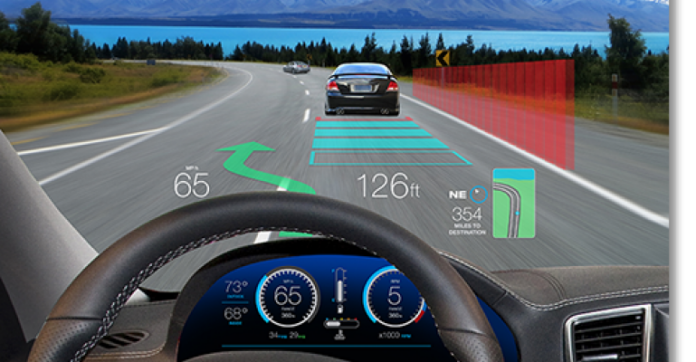By Mike Juran and Barry Pompea
The move toward semi-autonomous and fully autonomous vehicles will even further accelerate the need for AR-based safety features. If you think advanced technology can’t become a necessity, consider that only half of all U.S. car models had rear-facing safety cameras in 2012. By 2018 they were required equipment.
AR has the ability to enhance the driving experience in ways that other technologies simply cannot match. From hazard avoidance to location-based updates, augmented reality is unequaled for the speed and relevance in which it can deliver important driver information.
HUDs (heads-up display) are the natural place for AR to make its mark. A few vehicles offer some form of AR in the dashboard, but this can be problematic if it distracts from driving. For most drivers, information presented in their direct line of sight is far safer.
Important design principles are required for AR-enhanced HUDs. Some developers have imagined entire windshields as canvases for AR information, but this is not a good idea.
It’s possible to overstimulate the driver with advisories, warnings, readouts and the like. Excessive information density requires a degree of mental effort that can overwhelm decision-making and actually decrease reaction time.
The correct discipline when designing AR in HUDs lies in managing cognitive load. Driving is a complex task, with input coming from dozens of sources. As information density increases, so does the cognitive load. Information cannot be allowed to interfere with the normal demands of driving.
Cueing, for example, allows a designer to increase information while simultaneously lowering task load and reaction time.
This has an Eyes-on-the-Road Benefit (ERB), eliminating the time required to target a turn compared with looking at SatNav in the dashboard area. AR cueing can also be used to highlight obstacles (e.g., an unexpected pedestrian in the car’s path). When milliseconds count, such cueing can make all the difference.
AR HUDs must also be contextually aware; in other words, they must be aware they are “drawing” in the real-world space. Graphical signifiers should be presented only when needed in critical situations, hidden when not needed and expressed using a familiar design language (i.e., shapes, colors, even sounds) operators are conditioned to recognize.
Multi-modality, another design concept, ensures drivers have multiple ways in which to interact with what is in the HUD. Voice recognition is one of the many modalities that should be provided.
AR animations have been experimented with in HUDs since 2012; color has been added, and new ideas incorporate POI cueing, real-time parking space detection, bicycle highlighting, even virtual crosswalk and road-edge warnings.
This is especially useful when renting a car in a foreign country, as this will allow a jet-lagged driver to see a HUD that they’re already acquainted with – thus eliminating the cognitive load that comes with learning an unfamiliar system. Through computer vision and the cloud, this system could even translate local road signs and more all in real time.
As AR technology becomes more affordable, it will soon find its way into midrange vehicles.
Juran, Mike, and Barry Pompea. “Augmented Reality HUDs Will Make Vehicles Safer, But There’s a Catch.” WardsAuto, 11 Sept. 2020.
www.wardsauto.com/vehicles/augmented-reality-huds-will-make-vehicles-safer-there-s-catch
Analysis–
This article discusses the benefits of an AR heads-up Display while addressing the details in the design of the HUD in order to prevent distractions that can be harmful when driving. The authors take into consideration how the amount of information displayed and how it is displayed to help the driving experience. I think this is a great article to reference when thinking about using AR in any mode of transportation.
I find this article to be relevant to my research topic because I am interested in AR technology and seeing how that could be implemented to help essential workers in the transportation sector. Bus drivers typically are great drivers and must know the streets well but when driving in unfamiliar areas they may have trouble. AR can help with this or it could even help them when they are assisting passengers. There is so much that AR technology can offer.




